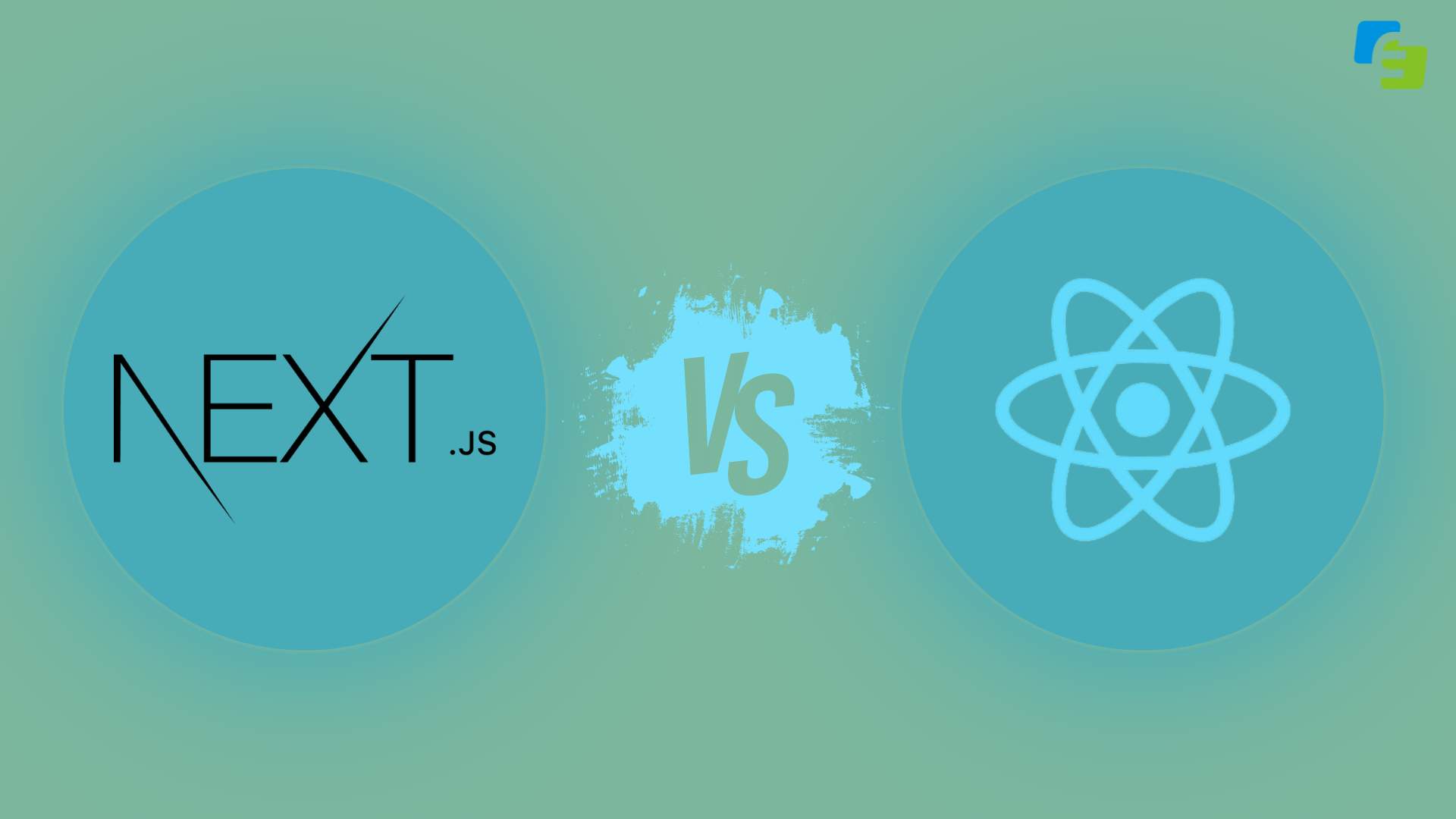Introduction
The success of your projects can be greatly impacted by selecting the appropriate front-end framework in the quickly changing field of web development. Developers are faced with a plethora of possibilities in 2024, all competing to be the preferred solution. Still, Next.js and React.js are the two front-runners that stand out the most.
According to recent surveys, demand for skilled Next.js and React.js developers has soared by 25% compared to the previous year. With such staggering statistics, it’s evident that mastering these frameworks can open doors to lucrative opportunities in the tech industry.
Now, let’s delve deeper into the debate of Next.js vs React.js, exploring their features, advantages, and which framework may reign supreme for front-end development in 2024.
What is Next.JS?

Next.js emerges as a powerhouse in the realm of React frameworks, offering a versatile toolkit for building server-side rendered (SSR) or statically generated (SSG) web applications. With its seamless integration with React, Next.js streamlines the development process, empowering developers to create dynamic and performant web experiences.
Key Features of Next.js:
- Automatic Code Splitting: Next.js automates the splitting of JavaScript bundles, optimizing page load times and enhancing user experience.
- Server-side Rendering (SSR): Leveraging SSR, Next.js renders web pages on the server before delivering them to the client, leading to faster initial page loads and improved SEO.
- Static Exporting: Next.js facilitates the generation of static HTML files for each page, enabling efficient deployment and scaling of applications.
(Source: Next.js Documentation)
What is React?

React.js, developed by Facebook, revolutionized the way developers build user interfaces with its declarative and component-based approach. As a JavaScript library, React simplifies the creation of interactive UIs, making it a favorite among developers worldwide.
Key Features of React.js:
- Virtual DOM: React employs a virtual representation of the DOM, enabling efficient updates and rendering of UI components, thereby enhancing performance.
- Component-based Architecture: React’s modular structure encourages the creation of reusable and encapsulated components, fostering code maintainability and scalability.
- JSX Syntax: React introduces JSX, a syntax extension that allows developers to write HTML-like code within JavaScript, enhancing code readability and productivity.
(Source: React.js Documentation)
NextJS vs React
While Next.js and React share a common foundation, they diverge in their approach to web development. Next.js extends React’s capabilities with built-in features tailored for server-side rendering and static site generation, whereas React focuses primarily on building UI components.
As we navigate the landscape of front-end development, it’s imperative to grasp the nuanced disparities between Next.js and React.js. These distinctions play a pivotal role in determining which framework best aligns with the objectives of your project. Let’s compare Next.js and React as it’ll reveal nuanced differences that influence their suitability for various projects.
| Feature | Next.js | React |
|---|---|---|
| Purpose | Designed for server-side rendering (SSR) and static site generation (SSG), excelling in SEO-friendly and high-performance web applications. | Primarily a JavaScript library for building user interfaces, focusing on creating reusable components and efficient state management. |
| Architecture | Integrates React with server-side rendering capabilities, enabling faster page loads and enhanced SEO. | Employs a component-based architecture centered around the virtual DOM, facilitating efficient updates and rendering of UI components. |
| Routing | Offers built-in routing functionality, simplifying navigation and page transitions within applications. | Requires additional libraries or frameworks, such as React Router, for implementing routing in applications. |
| File Structure | Provides a predefined file structure, guiding developers in organizing their codebase and facilitating project scalability. | Offers flexibility in file structure, allowing developers to structure projects according to their preferences and project requirements. |
By understanding these distinctions, developers can make informed decisions when selecting the appropriate framework for their front-end development endeavors.
Advantages and Disadvantages of Next.js and React
Both Next.js and React offer unique strengths and weaknesses that developers must consider when selecting the appropriate framework for their projects.
Advantages of Next.js:
- Improved SEO: Next.js excels in SEO optimization due to its server-side rendering capabilities, ensuring that search engines can easily crawl and index web pages for better visibility.
- Better Performance: With features like automatic code splitting and server-side rendering, Next.js enhances performance by reducing initial page load times and optimizing resource utilization.
- Simplified Deployment: Next.js simplifies the deployment process with its static exporting feature, enabling seamless scaling and hosting of applications on various platforms.
Advantages of React:
- Large Ecosystem: React boasts a vast ecosystem of libraries, tools, and community support, providing developers with ample resources to accelerate development and address diverse requirements.
- Flexibility: React’s component-based architecture offers unparalleled flexibility, allowing developers to compose complex UIs from reusable and composable components, thus promoting code reusability and maintainability.
- Community Support: With a vibrant community of developers and contributors, React benefits from continuous updates, enhancements, and best practices, ensuring its relevance and longevity in the ever-evolving tech landscape.
Disadvantages of Next.js:
- Learning Curve: Despite its advantages, Next.js may have a steeper learning curve for beginners due to its additional concepts and features, such as server-side rendering and routing.
- Complexity: Implementing server-side rendering and static site generation with Next.js may introduce complexity to the development process, requiring careful planning and architectural decisions.
Disadvantages of React:
- Boilerplate Code: React applications often require additional boilerplate code for managing state, routing, and other functionalities, which can increase development time and complexity.
- Configuration Overhead: Setting up a React project from scratch may involve configuring build tools, libraries, and dependencies, which can be daunting for newcomers and lead to potential configuration errors.
Is Next.js Better Than React?
Determining whether Next.js is superior to React entails evaluating various criteria such as performance, SEO optimization, and developer experience. While both frameworks have their strengths, Next.js shines in specific use cases where server-side rendering and SEO are paramount.
Performance: Next.js, with its server-side rendering and automatic code splitting features, typically outperforms React in terms of initial page load times and resource optimization. By pre-rendering pages on the server, Next.js reduces time-to-content and enhances perceived performance, especially for content-rich applications.
SEO Optimization: Next.js’ server-side rendering capabilities make it inherently better suited for SEO optimization compared to React, which primarily relies on client-side rendering. Search engines favor server-rendered content as it allows them to crawl and index web pages more effectively, resulting in improved search visibility and rankings.
Developer Experience: React’s large ecosystem and flexible architecture make it appealing to developers seeking customization and control over their projects. However, Next.js simplifies certain aspects of development by providing built-in features for server-side rendering and static site generation, thereby streamlining the development process and reducing the need for external dependencies.
While Next.js offers distinct advantages in terms of performance and SEO optimization, React remains a viable choice for projects that prioritize flexibility and customization. Developers should assess their project requirements and objectives carefully to determine which framework aligns best with their needs.
Will Next.js Replace React?
The question of whether Next.js will replace React is a topic of much debate in the web development community. While Next.js extends React’s capabilities with built-in features for server-side rendering and static site generation, it’s unlikely to replace React entirely.
Next.js and React serve distinct purposes and cater to different aspects of web development. React, with its focus on building reusable UI components and managing state, remains a fundamental tool for front-end development. On the other hand, Next.js enhances React by providing additional features for server-side rendering and SEO optimization, making it an attractive choice for projects with specific requirements.
Moreover, React’s widespread adoption and established ecosystem make it deeply entrenched in the developer community. Many developers are familiar with React and have invested time and resources into mastering the framework, further solidifying its position in the industry.
Instead of replacing React, Next.js complements it, offering developers a powerful toolkit for building dynamic and performant web applications. By leveraging the strengths of both frameworks, developers can harness the full potential of modern web development technologies and deliver exceptional user experiences.
Should You Learn Next.js or React?
For developers navigating the ever-evolving landscape of front-end development, the question of whether to prioritize learning Next.js, React, or both is a crucial consideration. Each framework offers unique advantages and caters to different project requirements, making it essential to weigh the pros and cons carefully.
Learning React:
- React’s widespread adoption and vast ecosystem make it a valuable skill for developers entering the field of front-end development.
- Mastery of React enables developers to build reusable UI components, manage state effectively, and create interactive user interfaces with ease.
- With React’s popularity and demand in the job market, proficiency in React can open doors to a wide range of career opportunities and lucrative positions.
Learning Next.js:
- Next.js extends React’s capabilities with features for server-side rendering, static site generation, and SEO optimization, making it a valuable addition to a developer’s skill set.
- Mastery of Next.js empowers developers to build performant and SEO-friendly web applications, enhancing their competitiveness in the job market.
- Given the growing demand for Next.js developers and the framework’s potential to revolutionize web development, learning Next.js can future-proof a developer’s skill set and increase their marketability.
Learning Both:
- Learning both React and Next.js allows developers to leverage the strengths of each framework and tackle a broader range of projects effectively.
- By mastering both frameworks, developers can choose the most appropriate tool for each project based on its requirements, objectives, and constraints.
- Additionally, proficiency in both React and Next.js demonstrates versatility and adaptability, positioning developers as valuable assets in today’s dynamic tech industry.
Whether to learn Next.js, React, or both depends on factors such as career goals, project requirements, and personal preferences. While React remains a cornerstone of front-end development, Next.js offers additional features and capabilities that can enhance developers’ skill sets and marketability. Ultimately, aspiring developers should consider their long-term objectives and the evolving demands of the industry when making decisions about which frameworks to prioritize learning.
When to Use React Over Next.js?
While Next.js offers powerful features for server-side rendering and SEO optimization, there are scenarios where React may be a better fit for your project requirements.
- Single-Page Applications (SPAs): If your project revolves around building dynamic, highly interactive applications that rely heavily on client-side rendering, React is an ideal choice. React excels in creating SPAs where user interactions drive content updates without the need for frequent server requests.
- Custom Routing Requirements: If your project requires complex routing logic or custom routing configurations that go beyond the capabilities provided by Next.js, React’s flexibility allows you to implement custom routing solutions tailored to your specific needs. React Router, a popular routing library for React, offers extensive routing capabilities and customization options.
- Existing React Ecosystem Integration: If your project is part of a larger ecosystem or relies on existing React components, libraries, or tools that are not compatible with Next.js, opting for React ensures seamless integration and compatibility with your existing codebase.
- Client-Side Rendering (CSR) Preference: In cases where server-side rendering or static site generation is not a priority, and you prefer the simplicity and efficiency of client-side rendering, React provides a lightweight and straightforward solution for building UIs that render on the client side.
- Minimal Configuration Requirements: If your project requires minimal setup and configuration overhead, React’s simplicity and minimalistic approach make it an attractive choice. React projects typically involve less boilerplate code and configuration compared to Next.js, making them easier to set up and get started with.
Opting for React over Next.js In these scenarios allows you to leverage React’s strengths in building dynamic, client-side rendered applications while avoiding the additional complexity and overhead associated with server-side rendering and static site generation.
When to Use Next.js Over React?
While React is a versatile and powerful framework for building user interfaces, there are specific scenarios where Next.js offers compelling advantages over React.
- Server-Side Rendering (SSR) Requirement: If your project prioritizes server-side rendering for improved performance, SEO optimization, and better initial page load times, Next.js is the preferred choice. Next.js simplifies SSR implementation with built-in features, allowing you to render pages on the server and deliver pre-rendered HTML to clients.
- SEO Optimization Priority: For projects where SEO is a critical factor in driving organic traffic and improving search visibility, Next.js’ SSR capabilities provide a significant advantage. By rendering pages on the server, Next.js ensures that search engines can easily crawl and index your content, resulting in higher search rankings and better discoverability.
- Static Site Generation (SSG) Benefits: If your project requires static site generation for faster content delivery and improved scalability, Next.js excels in generating static HTML files for each page. Next.js’ SSG feature enables efficient deployment and scaling of applications, making it ideal for projects with content that doesn’t change frequently.
- Improved Performance Needs: When performance is a top priority and you need to optimize page load times and resource utilization, Next.js offers features like automatic code splitting and server-side rendering that enhance performance significantly compared to client-side rendering approaches.
- Simplified Deployment Requirements: If your project demands simplified deployment and scaling processes, Next.js’ static exporting feature streamlines the deployment process by generating static HTML files that can be deployed to various hosting platforms and content delivery networks (CDNs) with ease.
Next.js provides distinct advantages over React by offering features and capabilities tailored to specific project requirements, such as server-side rendering, SEO optimization, and simplified deployment processes.
By carefully evaluating your project needs and considering the strengths of both frameworks, you can make an informed decision about whether Next.js or React is the right choice for your front-end development endeavors in 2024.
Conclusion
With front-end development being a dynamic field, selecting between Next.js and React.js can have a big impact on developer productivity and project success. As this blog has shown, each framework has its own advantages and covers a variety of use cases, so developers must carefully consider the needs of their projects before selecting one over the other.
From its robust server-side rendering capabilities to its seamless integration with React, Next.js emerges as a compelling choice for projects that prioritize performance, SEO optimization, and simplified deployment processes. On the other hand, React’s flexibility, large ecosystem, and client-side rendering prowess make it an invaluable tool for building dynamic, interactive user interfaces and single-page applications.
It is imperative for developers to stay up to date on the newest trends, technologies, and best practices in order to be competitive in the present tech market as we negotiate the intricacies of front-end development in 2024 and beyond. Continual learning and adaptation are essential to staying ahead in today’s fast-paced digital landscape, regardless of whether you decide to master React, Next.js, or both.
We invite you to share your thoughts, questions, and experiences with Next.js and React in the comments below. Which framework do you prefer, and why? What are your thoughts on the future of front-end development, and which framework do you believe will dominate the landscape in the years to come? How have you leveraged Next.js and React to tackle challenges in your projects? Let’s continue the conversation and empower each other to create exceptional web experiences in 2024 and beyond.
Thank you for reading. For continued insights and in-depth discussions, please follow our blogs at Ezeiatech.







